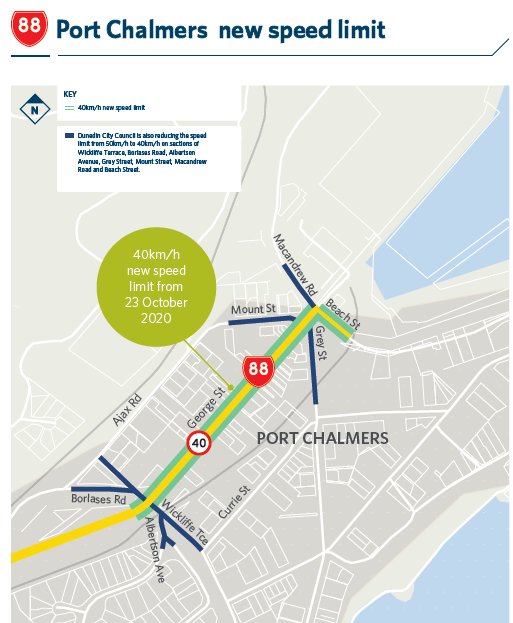Following public consultation and a thorough speed review process, Waka Kotahi NZ Transport Agency has set a new safe and appropriate permanent speed of 40km/h on SH88 through Port Chalmers.
During September and October 2019 Waka Kotahi NZ Transport Agency consulted on a safe and appropriate speed limit on SH88 through the main street of Port Chalmers, a busy container port town 12km east of Dunedin.
This highway is the main road freight route to the local port, and so is used by large numbers of heavy trucks. More traffic and pedestrians are in the town, with cruise ships calling at the port in the summer visitor season.
For the last 10 years the local community has been advocating for a lower speed limit than the current 50km/h on SH88 through Port Chalmers. Waka Kotahi is committed to making this highway safer for everyone, so they get to where they are going safely. The best option for achieving this was to review the current highway speed limit.
Locals have given several reasons for wanting a lower speed limit, including the large number of heavy vehicles on this route, pedestrian safety, poor visibility for drivers and pedestrians on parts of the highway, and a challenging road environment at the Beach Street end of SH88 where four local roads converge with the highway.
In 2018, the average daily vehicle count on SH88 through Port Chalmers was 5,000, a 5% increase on four years earlier.
During consultation we proposed reducing the existing 50km/h speed limit to 40km/h over a 600m section of SH88 between Wickliffe Terrace and the Beach Street rail crossing in Port Chalmers. This 40km/h speed limit is now the new permanent highway speed limit from Friday, 23 October 2020.

Several factors were considered when we determined the new speed limit we would consult on. These included the current average highway vehicle speed (between 45-49km/h), the number of heavy vehicles using the highway, pedestrian safety, and poor driver and pedestrian visibility on certain parts of the highway. There was also input from a range of technical and stakeholder experts.
SH88 through Port Chalmers is a key road freight route to the local port, and has become a popular visitor destination, with significant commercial activity and many more pedestrians in Port Chalmers during the summer cruise ship season.
Waka Kotahi considered a lower 30km/h speed limit. After assessing the road environment and level of activity, particularly pedestrians over a full 24-hour period this section of road didn’t support a 30km/h speed limit. To safely implement this (either permanent or seasonal) would require considerable engineering work such as reallocating road space, taking out on-highway car parks and kerb build outs. These would significantly change the current highway environment and compromise the full range of activities this route supports, including providing a critical road freight link to the local Port.
In this context Waka Kotahi considered that a 30km/h limit isn’t appropriate and that a 40km/h limit is a safe and appropriate speed across a full 24-hour period.
The last five years has seen two non-injury crashes and one minor injury crash on SH88 through Port Chalmers.
The new permanent speed limits will have little impact on travel times. Over the 600m length of SH88 through Port Chalmers the increase in travel time for highway users will be less than 8 seconds.
Find out more about the SH88 Port Chalmers permanent speed limit by reading the frequently asked questions.
Public consultation closed at 5pm on 7 October 2019.
220 submissions were received during the consultation period from stakeholder organisations and the public.
More information about speed and the speed review process is available on the Speed Review Programme webpage.